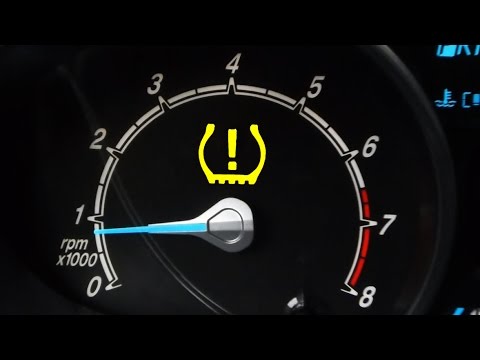To reset a tire pressure sensor, first, check and adjust the tire pressure. Then, drive the vehicle for a few miles.
Tire pressure sensors are vital for maintaining optimal vehicle performance and safety. They alert drivers when tire pressure is too low, preventing accidents and extending tire life. Resetting these sensors can be necessary after tire maintenance or pressure adjustments. Accurate tire pressure ensures better fuel efficiency and a smoother ride.
It’s a straightforward process that typically involves checking and adjusting the tire pressure and then driving the vehicle to recalibrate the sensors. Regular monitoring and resetting of tire pressure sensors can save money and improve driving safety.
Introduction To Tire Pressure Sensors
Tire pressure sensors keep your tires at the right pressure. They are part of the Tire Pressure Monitoring System (TPMS). The TPMS alerts you when tire pressure is too low. This helps prevent accidents and improves fuel efficiency.
The Role Of Tire Pressure Monitoring
The TPMS has a critical role in vehicle safety. It continuously checks the pressure in your tires. If the pressure is low, it sends a warning light on the dashboard. This helps you maintain the correct tire pressure and avoid potential hazards.
Proper tire pressure extends tire life. It also improves fuel efficiency. Low tire pressure can cause tire blowouts. The TPMS helps avoid such risks.
Signs Of A Malfunctioning Sensor
Sometimes the TPMS sensor may malfunction. Here are some signs of a faulty sensor:
- The warning light stays on even with correct tire pressure.
- The warning light flashes and then stays solid.
- Inconsistent tire pressure readings.
Understanding these signs can help you identify and fix sensor issues. Check your sensor if you notice any of these signs.
Initial Checks Before Resetting
Before you reset a tire pressure sensor, you need to do some initial checks. These checks ensure that the sensor reset will be successful. Skipping these steps might lead to improper sensor function.
Inspecting Tires For Physical Issues
First, inspect your tires for any visible damage. Look for cuts, punctures, or bulges. Damaged tires can cause incorrect sensor readings.
- Check for nails or sharp objects stuck in the tire.
- Look at the tire tread for uneven wear.
- Examine the sidewalls for any cracks or bubbles.
Fix any physical issues before resetting the sensor. This ensures accurate readings.
Verifying Tire Pressure
Next, verify the tire pressure using a reliable gauge. Incorrect tire pressure can trigger the sensor warning.
- Find the recommended tire pressure for your vehicle. This info is usually on a sticker inside the driver’s door.
- Use a tire pressure gauge to check each tire.
- Compare the gauge reading to the recommended pressure.
- Add or release air to match the recommended pressure.
Properly inflated tires help the sensor work correctly. Do these steps for all four tires.
| Tire | Recommended Pressure (psi) | Actual Pressure (psi) |
|---|---|---|
| Front Left | 35 | 33 |
| Front Right | 35 | 34 |
| Rear Left | 33 | 33 |
| Rear Right | 33 | 32 |
Remember, accurate tire pressure ensures the sensor reads correctly. This step is crucial for a successful reset.
Manual Reset Procedures
Resetting a tire pressure sensor can be simple. You can do it manually. Let’s explore two effective methods.
Inflating And Deflating Method
This method involves adjusting the tire pressure. Follow these steps:
- Turn off your vehicle.
- Inflate all tires to the recommended pressure.
- Deflate the tires completely.
- Inflate the tires again to the correct pressure.
- Start your vehicle.
- Drive for a few minutes.
Check if the tire pressure light turns off. If not, repeat the steps.
Using The Reset Button
Many vehicles come with a reset button. This button is usually under the steering wheel. Here’s how to use it:
- Turn the ignition key to the “On” position.
- Locate the reset button.
- Press and hold the reset button.
- Wait for the tire pressure light to blink three times.
- Release the button.
- Start the vehicle.
Your tire pressure sensor should reset. Ensure you follow these steps carefully.

Resetting Through The Vehicle’s Interface
Resetting a tire pressure sensor can be simple. Many modern vehicles allow you to reset the sensor through the vehicle’s interface. This method is often straightforward and does not require any special tools.
Navigating The Dashboard Menu
First, you need to locate the dashboard menu on your vehicle. This menu is usually accessible through the steering wheel controls or a touch screen.
- Turn on the ignition but do not start the engine.
- Find the menu button on your dashboard or steering wheel.
- Scroll through the menu until you see the tire pressure section.
Refer to your vehicle’s manual if you have trouble finding the menu. Each car model may have a slightly different interface.
Activating The Reset Via Onboard System
Once you have navigated to the tire pressure section, you can activate the reset.
- Select the tire pressure monitoring system (TPMS) option.
- Look for a reset button within this section.
- Press and hold the reset button until the TPMS light blinks.
Wait for a few moments. The system will recalibrate the sensors. You should see a confirmation message on the screen. The TPMS light should turn off if the reset is successful.
| Step | Action |
|---|---|
| 1 | Turn on the ignition, but do not start the engine. |
| 2 | Access the dashboard menu. |
| 3 | Select the TPMS option. |
| 4 | Press and hold the reset button. |
| 5 | Wait for the TPMS light to blink and reset. |
Tools To Aid In Resetting
Resetting your tire pressure sensor can be a simple process. The right tools make this task easier and more accurate. Using these tools ensures your tires maintain the correct pressure, improving both safety and fuel efficiency.
Utilizing A Tpms Reset Tool
A TPMS reset tool is designed specifically for resetting tire pressure sensors. This tool communicates with your vehicle’s onboard computer. It resets the sensor readings to the correct levels.
Steps to use a TPMS reset tool:
- Turn on the vehicle’s ignition but do not start the engine.
- Connect the TPMS reset tool to the OBD-II port.
- Follow the tool’s instructions to reset the sensors.
- Turn off the ignition and disconnect the tool.
These tools are user-friendly and often come with detailed instructions. They are a good investment for regular maintenance.
When To Consider Professional Equipment
In some cases, a simple TPMS reset tool may not suffice. Professional equipment may be necessary for more complex issues. These tools provide more advanced diagnostics and solutions.
Situations requiring professional equipment:
- Persistent TPMS warning light
- Multiple sensor failures
- Inconsistent sensor readings
Professional equipment is typically found at automotive shops. These tools offer comprehensive diagnostics and repair options. While more expensive, they ensure thorough and accurate results.
Choosing the right tool depends on your specific needs. For most, a TPMS reset tool will suffice. For more complex issues, professional equipment is recommended.
Troubleshooting Persistent Issues
Resetting a tire pressure sensor can sometimes be tricky. Some issues may persist even after following standard procedures. This section aims to address these common problems and offer solutions. Knowing when to seek professional help can save you time and effort.
Common Reset Failures And Solutions
Here are some common reset failures and their solutions:
- Sensor Not Responding: Ensure the sensor is properly installed. Check the battery if it is a battery-operated sensor.
- Incorrect Tire Pressure Reading: Use a reliable tire pressure gauge to double-check the readings. Inflate or deflate the tires to the recommended levels.
- System Error Message: Refer to your vehicle’s manual for specific error codes. Perform a system reset by disconnecting the car battery for a few minutes.
When To Seek Professional Help
Sometimes, DIY methods may not resolve the issue. In such cases, seek professional assistance.
| Issue | When to Seek Help |
|---|---|
| Persistent Error Codes | Contact a certified mechanic. |
| Unresponsive Sensor | Visit a tire specialist. |
| Frequent False Alarms | Get a complete diagnostic check. |
Following these guidelines can help you troubleshoot and resolve tire pressure sensor issues effectively.

Frequently Asked Questions
Can I Reset My Tire Sensors Myself?
Yes, you can reset your tire sensors yourself. Refer to your vehicle’s manual for specific instructions.
Where Is The Tpms Sensor Reset Button?
The TPMS sensor reset button is usually located under the steering wheel. Check the vehicle’s manual for exact location.
How Do I Turn Off The Tire Pressure Warning Light?
Check tire pressure and inflate to recommended levels. Drive for a few minutes. If light stays on, consult your manual.
Why Does My Tire Pressure Light Keep Coming On When My Tires Are Fine?
Temperature changes can cause tire pressure fluctuations, triggering the light. Faulty sensors or slow leaks might also be the issue.
Conclusion
Resetting your tire pressure sensor can increase safety and vehicle performance. Follow the steps outlined for accurate results. Regular maintenance ensures your sensors work effectively. Keep your tires properly inflated for optimal driving conditions. Don’t ignore sensor warnings; they help prevent potential issues.
Enjoy safer and smoother rides with well-maintained tire pressure sensors.





















